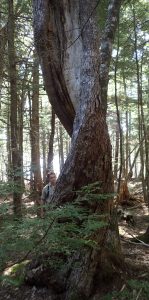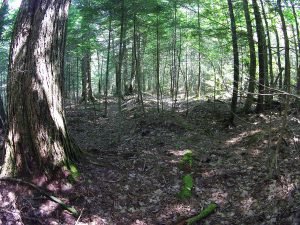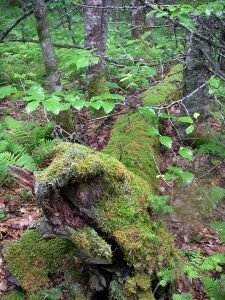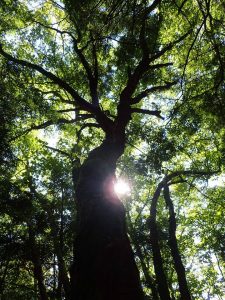‘Workin on it
View also submenu items
– Lynds & Leduc ’95
– GFE Guidelines
From Old Growth Forest Survey of Eastern Niagara Peninsula Phase 2/ Final Report
By Bruce Kershner, Project of Bert Miller Nature Club
Final Report to Trillium Foundation
October 2004
This is the best list I have seen pertinent to our forests. It was written to apply to forests of the Niagara Peninsula in Ontario, so there are differences in particular species between NS and the Niagara Peninsula, but the generic aspects apply pretty well to OG in Nova Scotia. (I will work on adding some comments.)
These observations by experienced naturalists of features of Old Growth provide can help us help “open our eyes” as we explore out own forests.
—————————–
Measurement of Tree Ages.
Increment Borer – used only when necessary. Very accurate, but invasive, laborious, time consuming
Counting rings of trees with exposed inner surfaces: blown down trees, trees cut when fallen across trails, stumps, hollow trees
Estimating tree ages by experienced
researchers – a forest of small and less mature trees is easy to recognize as non-old growth without need of any other method. Old growth experts can quickly distinguish very mature forests from old growth forests using experience and visual observation of physical indicators without needing to measure tree ages.
Assessment of Growing Conditions for that Site:
Is it poor growing conditions (slow growth)? If so, small diameters could still mean very old for that size tree.
Is it rich growing conditions (rapid growth)? If so, large diameters could mean trees are not as old as they look, not necessarily old at all. Matching with type of tree species (trees fall into fast, medium, or slow growing categories) and presence of old growth indicators below will determine answer.
Large Diameter Trunks (30 inches diameter or
greater)
Several “Big-Trees” per acre, preferably 8 or more per acre, are an excellent indicator. Most common “Big-Tree” species: oaks, maples, hemlock, pines, hemlock, ash, birch, beech, basswood, walnut, sycamore, black cherry
The Big-Tree Rule does NOT apply to fast growing trees that rarely grow in Old Growth Forests: willows, aspens, cottonwood, paper and gray birch
Lack of Big-Trees does NOT mean “not old growth.” Small-tree Old Growth is found in harsh environments such as rocky slopes, hilltops, cliffs, wetlands
Presence of Long-lived or Shade-tolerant Trees
Best indicators are hemlock, sugar maple, white and red oak, yellow and black birch, tulip tree, beech, black gum, white cedar, white ash, walnut
Trees that indicate it is NOT old growth (if numerous): willows, aspens, cottonwood, paper and gray birch, sumac, black locust
Presence of Commercially Very Valuable Species
Include medium to large black walnut, cedar, black cherry, white pine –excellent sign!
Old Growth Bark (“Antique Bark”) When trees reach 150 years old, the bark changes on most species, which looks very different from bark of younger trees
Excellent sign!: Balding bark, shaggy bark (separating or curling strips), craggy bark (deeply grooved, fissured bark), platy bark
Trees that display this: pines, maples, birches, oaks, tulip tree, sycamore, black gum, cottonwood, cucumber magnolia. Hemlocks get rusty-hued
Buttressed Trunk Bases
Trunk bases and roots flare out or swell at the base
Soaring Branchless Trunks with Lowest Bough at Great Height
Lowest bough starts at 25 to 40 feet up, or even as high as 60 to 90 feet!
“Stagheaded” Crown
Thick trunk ends in horizontally radiating short, craggy boughs bent at right angles – caused by centuries of damage and healing from ice and wind storms, lightning

Odd Trees have their place in Old Forests Twisted red maple in Old Forest by Sandy Lake (Bedford, N.S.) Sep 15, 2019. Ray Plourde spotted this one
Moss Grows Up the Trunk
The higher up a trunk that moss grows, the more confident that the tree is of great age. Reason: moss grows very slowly, and starts growing from the base (in our region – does not apply down upper mountain elevations, South, Pacific states
or Tropics). Best moss-growers: yellow birch, sugar maple, white ash, cucumber magnolia, white oak. Do not get moss mixed up with lichens, which can be light green
Bizarre Growth Forms The older a tree is, the more likely it is to grow into bizarre shapes. Others don’t become bizarre, but may just grow straight and towering
Knotty, Knobby, Gnarly, Burly, picturesque, charismatic, “misshapen” trunks
Spiral-Grain visible swirling up the trunk
Crooked Trunks Trunks growing at an angle “Leaners”, “Zigzag” trunks, trees growing on Stilt-Roots (hemlock, yellow birch) or trees with fused or intertwined trunks, branches or roots, including “Lover Trees” and “Window Trees, Dwarf Trees and trees whose shape deserves them to be nicknamed “Bonsai” Trees. These grow on cliffs or mountain summits
Cliff Trees Ancient trees associated with cliffs attain fantastic shapes, designated by nicknames such as “Daredevil” trees (trunks project horizontally out over cliffs, as much as 40 feet out), “Upsidedown” Trees (trunks hang down cliffs), “Root Ladder” trees. These are primarily cedars, hemlock, yellow and black birch

Pit and Mound topography at Sandy Lake. Growing evidence suggests Pit & Mound Topography is a consistent feature of Old Growth in Nova Scotia, as in Maine
Pit and Mound Shapes on the Forest Floor.
Depressions and mounds, 2 to 4 foot deep and high, are only caused by toppling of large trees in the long-ago past, which then decayed away to leave “grave monuments” as reminders they were there. If large trees grow among pitsand-mounds, it ensures a continuous time period of many centuries that large trees have made up this forest.
Past logging eliminates big trees (that can create pit-and-mounds, and agriculture flattens out pit-and-mounds. Absence of pit-and-mounds, however, does not mean much

Forest floor in OG red oak
Many Large Logs in Different Stages of Decay
Created by large standing trees that fall here and there over a long period of time, with the older logs reaching greater stages of decay. In contrast, logging (actually “de-logging”) in the past removes large trees that would otherwise contribute to the supply of older logs. Absence of logs, however, does not always imply anything.
Includes abundant “coarse woody debris” which means fallen branches, especially common in mountain and Northwoods forests. Lush moss layers often carpet the logs
Abundant and Diverse Populations of Fungi,
Mushrooms, Lichens, Mosses and Ferns
Old Growth Forests are the best place to find the most mushrooms, lichens, and primitive plants. Reason: large, continuous supplies of decaying logs; thick carpets of decaying leaves and rich organic soil; millennia of relatively stable
conditions for soil colonies of fungi to grow undisturbed, and no shocks from the introduction of bright light or drying conditions caused by logging or natural disasters. 51 species of lichen grow only in Old Growth Forests. Scarce fungi, moss or ferns does not imply much.
Absence or Minor Evidence of Logging or Human
Disturbance
A few, scattered stumps or minor signs of the above disturbance-indicators does NOT rule out an Old Growth Forest. It just indicates that it had some past disturbance.
Indicators that a Site May Not Be Old Growth
When disturbance-indicators are regular and common (and Old growth Indicators are rare or absent), it is definitely not old growth. The following signs indicate a site may NOT be Old Growth:
Numerous stumps
Logging road corridors through the forests
“Open-Grown” trees with branches that start 5 to 15 feet from the ground, spreading horizontally out (indicating the trees started in a sun-lit field or clearcut)
Trees that prefer to grow in young and disturbed
forests, such as aspen, black locust, white and gray birch, Manitoba maple (ash-leaf maple or box-elder), willow, hawthorn, Norway maple
Presence of planted or non-native trees, such as Norway spruce, Scotch pine, tree of heaven, Norway maple.
Certain trees with multiple trunks from their base
(“coppiced trees”), which means they sprouted from a stump. Applies to red and black oak, red maple, birches
Old stone walls running through the forest
—————–
Features of Old Growth Forests highlighted in “Old Growth” Forests Defined by Key Ecological Characteristics, By JOE RANKIN citing Andrew Whitman at the Manomet Center for Conservation Sciences and Shawn Fraver, a professor at the University of Maine’s School of Forest Resources December 20, 2016
– Walking into an old growth forest in Maine, the thing you notice is the trees are bigger, but there are fewer of them. If you hold your thumb out at arm’s length and spin in a circle you should “pick up 10 to 15 trees that appear as big or bigger than my thumb,” said Whitman.
– But there should also be younger trees, trees of various heights and ages, helping create a multi-layered canopy, filtering the light falling toward the forest floor, they said. Old growth does not mean all the trees are old.
– The other thing you should see is big standing dead trees and big dead trees lying on the forest floor, trees 15 inches in diameter or bigger, in various stages of decay. “You don’t get big logs until you get big trees,” said Whitman. “You’re looking at 250 years at least before you get those structural items on the forest floor.”
– The big trees should be plastered with lichens and festooned with epiphytes. Expect to see lush mosses and plants such as Coral Root and Indian Pipe. There should be liverworts and lungworts and a complex of mosses, including the Feathered Neckera, a characteristic moss of old growth forest. Below, in the spongy duff and under the many logs, you should find a variety of beetles, worms, spiders, millipedes and centipedes. You might hear pileated woodpeckers or catch a glimpse of a fisher in a tree.
– One other telltale feature of an old growth forest is the forest floor itself, said Whitman and Fraver. It’s not, by any means, level. Instead it’s characterized by dips and mounds. Not coincidentally they’re more or less the size of a large tree’s root ball and its accompanying soil. This “pit and mound” topography occurs when old big trees are blown down, their roots upended. The mound is created by the exposed root ball, the hollow is where it once was. Gradually, over decades, the root rots and both the mound and pit are colonized by mosses, ferns, wildflowers and young trees.
“It could take an old field a thousand years to get that pit and mound topography,” said Whitman. “In managed forests you rarely get that, because large trees are cut before they can fall down”
The lack of pit and mound topography is a good indication that the land was once smoothed by the plow, even if it was a century or two ago. For Fraver, there’s one pretty sure indication that a forest wouldn’t qualify it as old growth. “If I see cut stumps that is evidence that it’s been harvested.”
———————
Comment Re: “Multilayered canopy”: In old hardwood forests of NS, four or five layers can often be distinguished; here is a description for an Old Growth red oak stand on the Chebucto Peninsula (N.Hill and D.P.):
It is multi-aged, old growth oak forest with snags (standing dead trees) and fallen dead trees in a range of diameters. The overstory is made up mostly of red oak, some yellow birch and occasional white birch; red maple is common but tends to be overgrown by oak. There are distinct subcanopies of moose maple at about 7 – 9 m (20- 30′) height and witch hazel at 3 – 5 m (10- 15′) and a continuous low bush groundcover, typically less than 60 cm (2′) height. The groundcover is made up of blueberry, huckleberry, New York fern, bracken fern, lambkill, sasparilla, mayflower, Labrador tea (in pockets) and seedlings of red oak, red maple, moose maple, yellow birch, fir and occasional black spruce. We didn’t see any pine. Balsam fir is common on the forest floor but, except in a few larger gaps, does not grow more than about 3 m (10′) in height and then, apparently, dies.

Click on image for source document. Also view Photographs of Old Growth Red Oak and Red Spruce stands on the Chebucto Peninsula (Nova Scotia)
——–
Related:
Natural History of Forested Lands in King’s Co
Posted with permission of Blomidon Naturalists (View Post Jan 18, 2018)
Greater Fundy Ecosystem Guidelines
including Defining Mature Forest and Defining Old Growth

